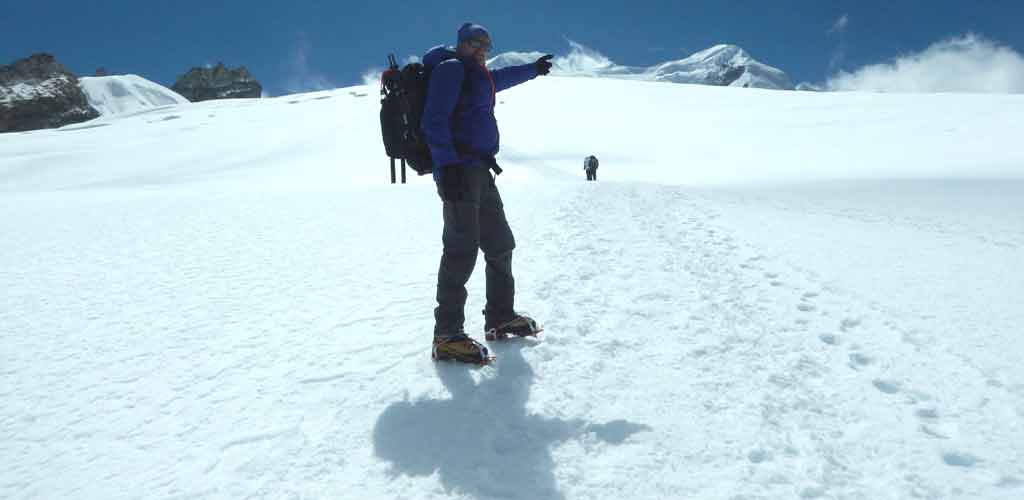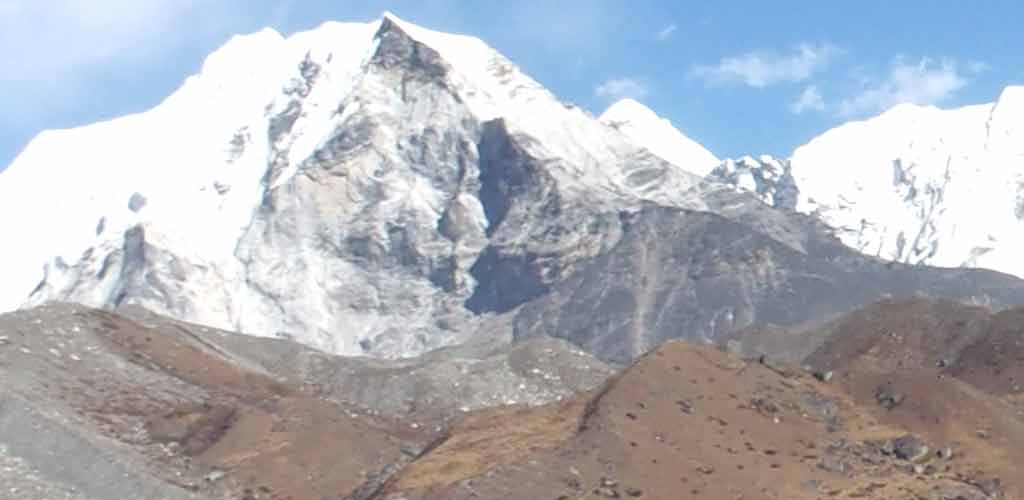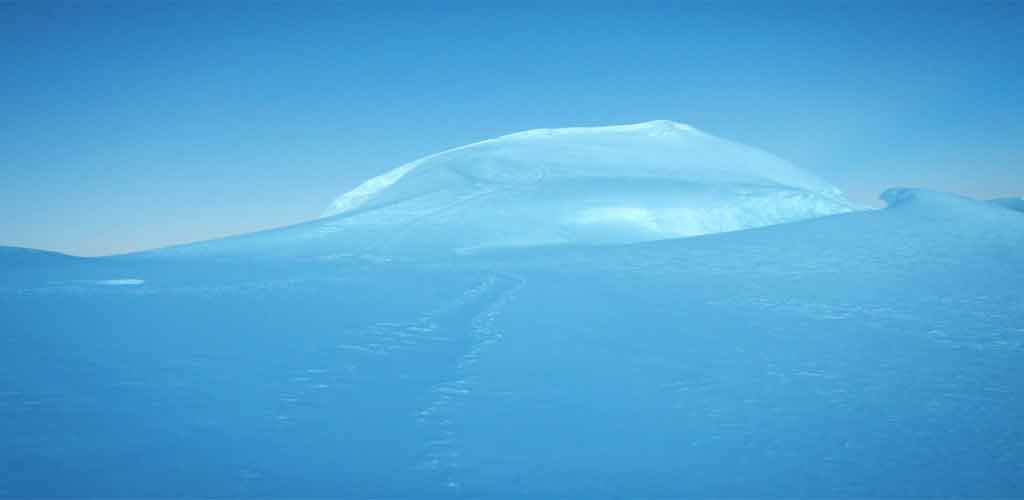NMA Peak Climbing Rules
NMA Peak Climbing in Nepal
In exercise of the powers conferred by the Government of Nepal, the Nepal Mountaineering Association (NMA) has made the following rules to be observed for the climbing of the peaks of Nepal Himalayas listed in Appendix 1′. These rules will come into force at once.
Definition: Where applicable definitions for these rules will be the same as those for the Government of Nepal Mountaineering Expedition Regulations 1979 and its First Amendment 1984.
Permission: Any person or mountaineering team desirous of climbing the peak listed in Appendix must receive permission from the Nepal Mountaineering Association. Application to climb the peak must be made in the form as prescribed in Appendix 2. Permission to climb the peaks will be granted for one month only. Permission may be extended, if necessary, for another period of two weeks. The period of permission granted relates to time spent climbing above the base camp. The trek to and from the base camp is not included. Application for a climbing permit may be made at any time by the concerned mountaineering team. The permit will be granted on a first come, first served basis. The right to permit another party to climb the same peak during the same period is reserved by the Nepal Mountaineering Association. Nepal Mountaineering Association will recommend to the Immigration Office of the Government of Nepal to obtain trekking permits for the area for the team members.

Peak climbing Permits: For extending permission, an additional 25% charge of the total amount of the initial fee will be made for each extra week. The leader or climbing member of the team must collect the permit in person from Nepal Mountaineering Association. The maximum number of people in a group is 12 people
Not Refundable Service: In the event of cancellation of the permission by NMA or the failure of the expedition to materialize due to some other reasons, the fees already paid will not be refunded. Every individual or party granted a climbing permit shall be accompanied by a climbing Sirdar/Guide, who must be registered with NMA.
Functions and duties of the Service: To assist the climbing party with the recruitment of porters and other staff, control of porters, local purchase of food, etc. And to solve any problem that may arise to the best of his ability.
Report to the Nepal Mountaineering Association in case the party spends more than the prescribed time limit on the mountain.
- To ensure that the climbers comply with the terms of their permit.
- To ensure that the climber’s trekkers follow the specified route.
- To ensure proper disposal of waste materials.
- To report to NMA any infringement of the climbing rules
Report any serious incidents to the nearest police post. The Sirdar Guide shall be employed from the day the climbing party begins the trek until the trek is finished. The Sirdar/Guide will be provided with the following facilities:-
Staff Salary Service: Minimum daily allowance to be paid as per the rules of the Government of Nepal, Ministry of Tourism, and Civil Aviation.

Clothing and Insurance: Climbing equipment and necessary clothing if required to go above the base camp. Insurance: – All employees going above the base camp must be insured for personal accidents to the value of Rs. 1500,000.
You need the NMA book necessary for Issuing climbing Permit: Nomination of representative in Kathmandu: Each party granted a climbing permit will nominate a representative in Kathmandu to act as the liaison between NMA and the climbing party. The representative may be an individual or an organization registered with NMA. The nominated representative will be responsible for making necessary arrangements for the climbing party in case of accidents or any other unforeseen circumstances.
Peak Climbing Rules: Submission of report: – After the climb and on return to Kathmandu, the party will submit a report to NMA. In the form prescribed in Appendix 4. Power to cancel the permit: NMA may cancel or withdraw the climbing permit at any time with or without showing any particular reason. Non-compliance with the regulation: Where any trekking party acts in contravention of the climbing permit or indulges in acts of unsocial or outrageous behavior contrary to the customs and culture of the people of Nepal, NMA may recommend to the Government of Nepal to take necessary measures by Article 37 of the Mountaineering Regulations 1979.
Base Camp Clean: Protection of Environment: – Base camp and other camps will be left perfectly clean after the climb. No foreign materials, such as fixed rope, pitons, etc. shall be left on the mountain. All rubbish and waste material must be burnt or otherwise disposed of in the Base Camp.

Revision of the Regulations: Any article of this regulation may be revised or amended by NMA with the prior permission of the Government of Nepal, with the Trekking Guidelines
Introduction: Because there is no immediate and direct threat to life, it is difficult to appreciate or to see the gradual diminution in the quality of life caused by the innumerable acts of environmental degradation.
Environment: Contamination of our Himalayan environment, together with an alteration in vegetation, drainage, and runoff patterns, has increased at an unprecedented rate.
The management of our ecology in a way that allows our valued trekkers and climber to still fulfill their aesthetic, cultural, and challenging needs, requires a committed sharing of responsibility.
NMA has uploaded the guidelines for you as one step towards making this partnership of caring for our mountains a reality. The contents suggest proven ways to protect our environment and stop the extinction of Nepal’s “endangered spaces”.
Trekking Preparation: If you decide to book through an agency, ensure it is a reputable firm that provides proof of its knowledge of the area you wish to visit, as well as of an environmental code of practice.
Destination: Select less-traveled routes to reduce the impact on popular trails; or
Select or ask to be guided on less-frequented alternative trails along the main route.
Group Size: Limit your party to about 10 if tenting; larger groups place more strain on tent sites.
Clothing: If concerned about being conspicuous, dark, or earthen-colored clothes, backpacks and tents blend in better with the natural surroundings. Carry a small stove and fuel for cooking to save on firewood. Take along a couple of garbage bags to save on firewood. Use a tent with poles and a waterproof floor to make it unnecessary to cut trees for tent poles or to dig a ditch for rainwater. Attach earphones to your indispensable? Radio or cassette player, so as not to disturb others at a campsite or on the trail.
Consider Living it Home: Repack food from aluminum foil, cans, and bottles into plastic bags to reduce weight, space, and litter. If it cannot be repacked, consider leaving it at home.
Photology: Respect for people, Keep discreet by not shouting or loudly playing a radio or cassette player.
Respect for wildlife: Help wild animals remain undisturbed by using only telephoto lenses or binoculars for close-ups. Leave wild animals to their natural diet by not feeding them. Do not carve on trees: you may scar them for life.
Respect for things: Leave alone stones, wood and metal statues, cravings, and shrines; never touch painted religious symbols, figures, frescoes, or other cultural-historical or archeological sites and artifacts. You can admire and photograph these, but also let future trekkers enjoy discovering them and, more importantly, respect the local people’s use of the above.
Never disturb moraine, glaciers, or ridge-top cairns; they may be essential navigation aids for traders, herders, and other travelers.
Trail hints: Stay off paths closed by logs or rocks; local people sometimes close certain paths that have been replaced by safer or better routes.
Do not shortcut obvious switchbacks; if others follow you, it will lead to erosion.
Spread out when walking off the path in flower meadows and avoid trampling some plants.

Lodges: If stopping to eat in the lodge, remember that local meals are usually prepared between 9.00 and 11.00 am; outside of those hours, extra firewood will be needed to prepare some times for you. In the evening, too, try to eat when others do.
Stoves: If camping out, use stoves whenever possible; stoves are mandatory in National Parks.
Portable stove cooking is fast and efficient and saves cutting firewood.23. Stoves are much safer when dryness, dense vegetation, or winds may create a fire hazard.
Always use stoves above the tree line to preserve sparse vegetation and to discourage the use of scarce firewood brought from a lower elevation.
-
Fires:
- 25. Built a fire as a last resort; use it only for cooking, and keep it small.
- 26. Built, where possible, on inorganic soil such as beaches, dry washes, or sand, or else on snow, rock, ice, or gravel.
- Ranging with rocks does not prevent a fire from spreading, so leave stones where they lie.
- 28. Built-in existing fireplace in high-use areas; douse with water when finished.
- 29. If you must be built on a previously unused site, then douse it with water, scatter ash, and “naturalize” the site when finished.
- Collect firewood some distance from camp and several locations so as not to deplete any one area.
- Collect only firewood that is dead, lying in the ground, and breakable with your hands; alternatively, purchase a load of firewood from a nearby farmer.
- LITERACY
- Hygiene:
- 33. Most items, clothing, and even bodies may be adequately cleaned without soap; if you do need soap, use a biodegradable type to minimize contamination of water and vegetation.
- Human Waste:
- Urinate on rocks instead of on vegetation to keep away salt-craving wildlife.
- 35. If urinating in snow, kick some over your urination to cover the color.
- Minimize health risks to others by defecating at least 30 meters away from trails, water, houses, campsites, and high waterlines by rivers and lakes.
- If you have diarrhea and/or the distance from the trail is limited by the terrain (e.g. steep slope above and below), then at least ensure that your feces are exposed to the sun and unlikely to be walked on; this way decomposition will be quicker.
- Learn to clean yourself from a “lota” (jug) of water, but if toilet paper is necessary, burn it after use.
- 39. Groups should use temporary latrines dug at least 20cm. deep and covered after usage with soil; with the pit full or site abandoned, covered latrine with a combination of soil, pine needles, cones, twigs, and small stones.
- 40. In snow, a concentration of waste will not decompose; so defecate in individual small holes that you cover with snow after use. Ideally, if you find an isolated spot that has little chance of being seen by someone else then defecate on the surface to expose your feces to the sun.
- Use toilets wherever they are available.
- Plain Garbage:
- Prepare to rinse and pack out what cannot be eaten or burned; only paper, tampons, and food scraps should be burned.
- Dumping juices out of cans may increase the number of bothersome and disease-carrying insects and other vertebrates; so drink it all or dilute it in wastewater.
- Widely scattered wastewater as well as animal and fish viscera on land. Pouring liquid cooking water in one spot contaminates the area with bad smells and attracts possibly hazardous insects, birds, and other animals.
- Use designated “refuse pits” where existing, for any metal, glass, or plastic garbage you truly are unable to carry out.
- Keep wrappers from chewing gum, candies, biscuits, medicine, or film in your pocket until you arrive at a village where disposal is possible; if inside a private house, ask permission before throwing anything into a fire.
- Improper garbage disposal increases the population of vertebrates which, in high densities, become sickly.
- Trash facts: an aluminum soft drink or beer can last for about 495 years; steel items for 95 years; ordinary plastics for 220 years; glass could last 1 million years. So don’t be a refuse-ink; pick up other people’s litter too!
- GET AR-RESTED
- 49. In popular areas with established campsites (such as terrain adjacent to a lodge, school grounds, and another demarcated land, set up your tents on one of the established fields to reduce the spread of impact.
- In remoter, less frequented areas selected a previously unused campsite to avoid creating sites that will be repeatedly used.
- 51. By rivers and lakes, camp below the high water line so that seasonal washes will clean the site.
- 52. Do not overload your campsite with too many people.
- Flat sites without vegetation and with good drainage are preferable.
- 54. Do not rearrange a farmer’s field! Leave undisturbed large fieldstones, fence stones, fence posts, scarecrows, soil, vegetation, and crops.
- 55. At high altitudes, vegetation needs the shelter of rocks, so moving them creates a permanent barren feature no matter how small.
- Spending just a few nights at any one tenting site.
- “Naturalize” the spot before leaving it.
